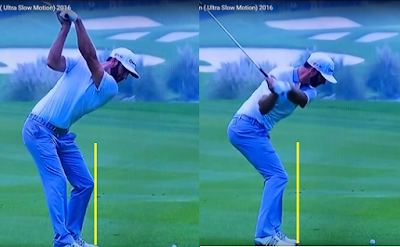Go to the 3:00 minute mark and I think George has a great way of describing how the trail leg and hip action should move. This is where you see a lot of the sliding of the pelvis and thus thrusting of the pelvis (i.e. goat humping/early extension) occur. The golfer uses the trail leg in a motion to push their lower body in a linear fasion instead of using their lead leg/lead hip to PULL the lower body in a rotational fashion.
I started to see this in my own swing and have noticed something that I had not seen before.
Here I have drawn a blue line on my left knee at the top of my swing (p4)
Now, let's compare that to Dustin Johnson.
And let’s compare that to Moe Norman, known for sliding his body quite a bit in the golf swing.
One of the things Moe said was ‘you gotta sit in your golf swing or you can’t do it.’ And that pulling and rotating of the left hip simulates a sitting motion.
And here’s Sam Snead:
Of course, Moe is a little past P5 due to his short backswing and Snead is just before P5 due to the camera speed. But, the picture shows a major difference in their hip, femur and pelvic motions in transition.
This pulling back motion from the lead leg and hip prevents the right leg and right hip from internally rotating and thus the linear ‘push off’ described in George’s video does not occur. That linear push off forces the arms to pull down and that causes the shaft to get a little too steep.
In my case, that not only causes some stop and go of the pivot motion, but I react to it by altering my neck tilts as my neck tilts downward in the downswing considerably. Take a look at the brim of my hat in the downswing.
In my case, that not only causes some stop and go of the pivot motion, but I react to it by altering my neck tilts as my neck tilts downward in the downswing considerably. Take a look at the brim of my hat in the downswing.
To me, I think it is so critical for golfers to be able to avoid that push off with the rear leg and foot in transition. Some can get away with it, but most cannot. It's an understanding and awareness that the lead leg/lead hip almost moves separately in transition from the rear leg/rear hip. And if well executed, it will mean that the rear leg/rear hip will be propelled into movement by the lead leg/lead hip's rotational movement. I try to visualize my right leg/right hip being 'frozen' while my left hip and left leg rotate so much that it finally forces my right leg/hip to rotate and move inward.
3JACK





2 comments:
Rich,
It is about time that you have eventually come around to understanding this important point - that the left buttocks must be pulled back to the tush line without the right buttocks prematurely leaving the tush line. If you want to understand the underlying biomechanics, which is based on using the 6 right-sided lateral pelvic rotator muscles to rotate the pelvis AWAY from the "stabilised" right leg/foot (that is stabilised by maintaining weight-pressure loading of the right leg during the transition), then you should read the following review paper at http://perfectgolfswingreview.net/pelvicrotation.html .
Jeff.
Good review - will hopefully inspire a few more visits. Surprised to sense an initial reluctance to visit this track from such a well-travelled golfer! Please continue to review more courses like this golf drivers top golf gears
Post a Comment